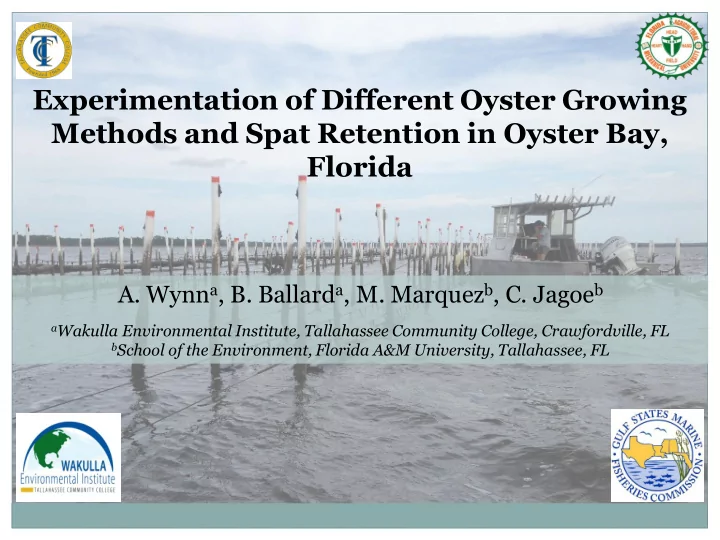

Experimentation of Different Oyster Growing Methods and Spat Retention in Oyster Bay, Florida A. Wynn a , B. Ballard a , M. Marquez b , C. Jagoe b a Wakulla Environmental Institute, Tallahassee Community College, Crawfordville, FL b School of the Environment, Florida A&M University, Tallahassee, FL
Research Site Oyster Bay, Florida WEI 5.5-acre aquaculture research site
Oyster Growing Methods Objective: Compare OysterGro Floating Cages vs Seapa Hybrid Cages 20,000 Triploid (3n) oysters Measure: Length Oyster Tissue Dry Weight Practicality of each Growing Method
Oyster Growth Length vs Days One Way RM ANOVA F (1,109) =2.038, p=0.156 *Not Significant
Oyster Growth Tissue DW vs Days One Way RM ANOVA F (1,105) =37.792, p<0.001 *Significant Difference
Oyster Growth Length vs Tissue DW One Way RM ANOVA F (1,109) =2.038, p=1.243 *Not Significant
Conclusions Length growth rates Not significant Oyster tissue biomass Significant Length vs oyster tissue biomass Not Significant Practicality Lost 9 of 12 Seapa Hybrid Cages during Hurricane Michael Lower mortality in OysterGro cages Higher mortality in Seapa due to increased temps / design.
Oyster Domes Objective: Determine the effects farms utilizing diploid (2n) oysters have on the wild oyster population. Measure: Oyster recruitment on cement oyster domes.
Design Intertidal 1’ Subtidal 3’ Subtidal Mean Low tide 4 Random samples (domes) per treatment monthly Seed Seed Seed Seed Seed Seed 4 25cm 2 quadrat measures (replicates) per sample Seed Seed Seed Seed Seed Seed Oyster Cover analyzed using ImageJ
Results • Predation changed designed Intertidal 1’ Subtidal 3’ Subtidal Depth comparison in oyster • percent cover • One Way RM ANOVA: • Arc sin x+1 transformation • Significant difference • F (2,76) =3.36, p=0.36 • Post-Hoc Tukey: • Significant difference in 1’ subtidal treatment (most oyster cover)
Final Results Intertidal 1’ Subtidal 3’ Subtidal After full Fall spawn Oyster Oyster Oyster Oyster Oyster Oyster Within two months Oyster Oyster Oyster Oyster Oyster Oyster Significant coverage inside Significant coverage outside as well on domes Spring spawn Oyster Oyster Oyster Oyster Oyster Oyster 300-500 mature Oysters High success rate of Oyster Oyster Oyster Oyster Oyster Oyster retention due to confined protected space.
Future Work So why is this important? Formulation of Advisory Council Scientific Experts, Past Students, Legislators, Business Leaders, Stakeholders, etc. Identify Challenges, mitigating factors Oyster Aquaculture: Environmental, Economic, and Legislative challenges. In Wakulla County, Oyster Aquaculture is third largest Employer After two years, 6-8 Million Oysters in Bay. From Barren Desert to teaming with life CLEAN WATER.
Future Work How can we export clean water – deployable? RESTORD-Tech (Restoring Seed Through Oyster Reef Dome Technology). Sarasota - $44,000,000.00 impact from RED TIDE Florida has the second largest coastline /Tourism Thousands of years Oyster Reefs were along Eastern Seaboard/ Nature took its course. Answers two questions: One of the answers to re-seeding Apalachicola Bay Will effectively combat Red Tide and other HAB’s
Acknowledgements GSMFC - Funding WEI Aquaculture Students and Staff FAMU Graduate/Under Grad Students Dr. Charles Jagoe (FAMU)
Aquaculture Research Worldwide Decline of Oyster Populations >1% of historical levels (FAO, 2014) Need for increased oyster production Increased demand of oyster production (consumption) Additional benefit is increased water quality Cleaner water Improved aquatic habitat Filter Feeding Remove organic matter Causes low dissolved oxygen levels Lower nutrient loading from terrestrial runoff
Aquaculture Research Waste Water Treatment is Limited Effective for land-based water Limited to coastal pollution/runoff While there is an increase in coastal pollution/excessive nutrient removal Studies show filter feeding shellfish can remove nutrients Providing an ecosystem service of water quality improvement (Beseres-Pollack et al., 2013; Bricker et al., 2014, 2015a, 2015b; Ferreira et al., 2007; Filgueira et al., 2014a, 2014b; Lindahl et al., 2005).
Aquaculture Research Eutrophication (excessive nutrients) Excessive algal blooms Harmful algal blooms (HABs) Lower Dissolved Oxygen Hypoxic/Anoxic Waters Loss of Seagrass Decreasing habitat Nurseries Less Oxygen
Recommend
More recommend